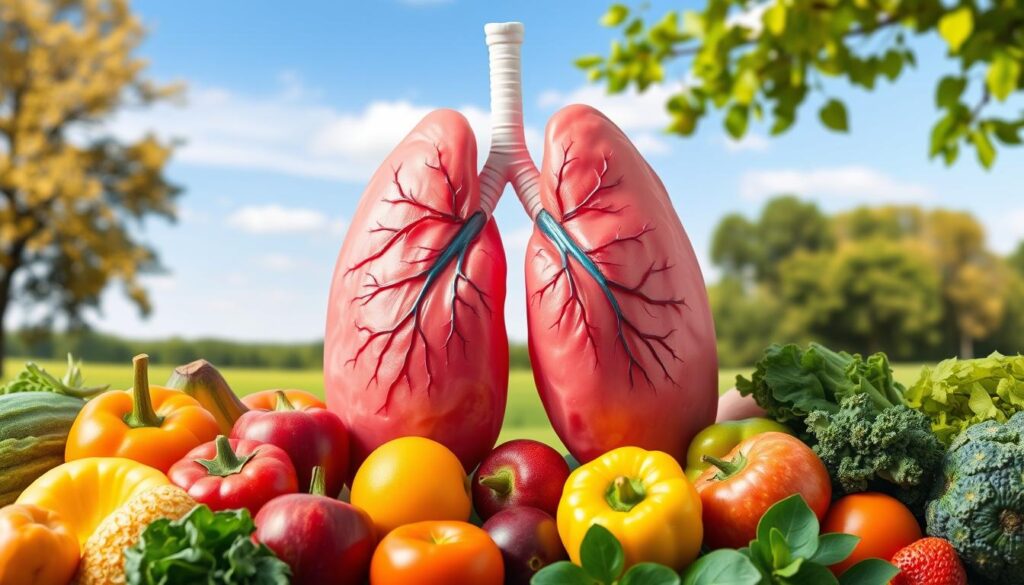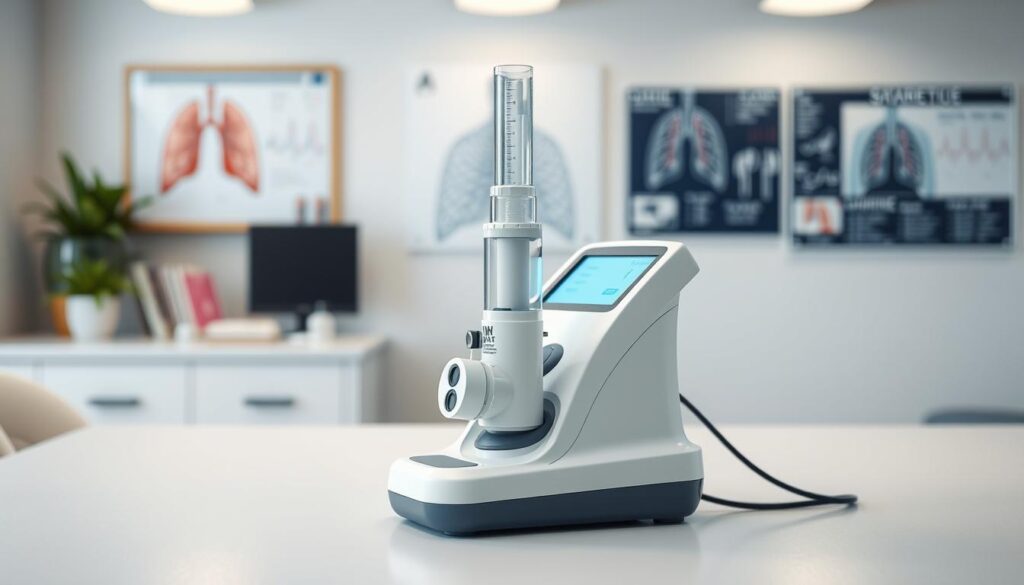As men hit their 40s, it’s key to focus on lung health. Our lungs change with age, affecting how well they work. In healthy adults, lungs can hold about 6 liters, like three big soda bottles.
But, lung function starts to drop slowly after 35. This makes breathing a bit harder over time.
Some changes in breathing are normal with age. But, sudden or severe breathing problems might mean a lung issue. In this article, we’ll look at ways to keep lungs strong. We’ll cover breathing exercises, lifestyle changes, and preventive steps for men in their 40s and beyond.
Understanding lung changes and taking action can help men stay healthy. This way, they can enjoy a better life as they get older.
Understanding Age-Related Lung Changes After 40
As we age, our bodies change in many ways. These changes can affect how well we breathe. After 40, it’s important to know these changes to keep our lungs working well.
Natural Decline in Lung Capacity
Even healthy, non-smokers see their lung function drop after 35. The amount of air we can exhale after a deep breath goes down by about 0.2 liters each decade. Also, the air we can blow out in one second decreases by 1 to 2 percent every year after 25.
How Aging Affects Respiratory Muscles
The muscles we use to breathe, like the diaphragm, get weaker with age. This is called respiratory muscle decline. Research shows a 2% yearly drop in muscle function as we get older. This makes it harder for our lungs to take in and push out air.
Changes in Lung Elasticity and Function
With age, our lung tissue loses some of its stretchiness. This makes our airways smaller and less flexible. Also, our rib cage might shrink, giving our lungs less room to expand when we breathe in. These changes in elasticity and function lead to a decline in lung function for many older adults.
Knowing about these changes is the first step to keeping our lungs healthy. It helps us take steps to reduce how much aging affects our breathing.
| Statistic | Value |
|---|---|
| Chronic lower respiratory tract disease mortality rate in those 65 and older | Third leading cause of death |
| US population aged 65 and over in 2010 | 40.3 million (13% of total population) |
| Increase in 65+ population from 2000 to 2010 | 15.1% (compared to 9.7% for total US population) |
| Prevalence of hyperkyphosis (excessive spinal curvature) in older adults | 20-40% |
| Annual decrease in respiratory muscle function with age | 2% |
The Vital Role of Smoking Cessation in Lung Protection
Quitting smoking is key for lung health as men age. Smoking causes most lung diseases, like COPD and lung cancer. In fact, it’s behind 90% of lung cancer deaths in men. Quitting smoking offers quick benefits.
Just 12 hours after quitting, blood carbon monoxide levels return to normal. Lung function starts to get better in a few months. Within a year, heart disease risk drops by half. Counseling and medication can help you quit for good.
Statistics show why quitting smoking is so important. A 40-pack-year smoker inhales about 290,000 cigarettes by 60. Smoking also causes 123,836 lung cancer and 90,582 COPD deaths yearly in the U.S.
Tobacco smoke has thousands of harmful chemicals. These can harm the lungs and cause diseases like COPD and asthma.

Good news: lung cancer risk drops with each year of not smoking. Even after years, quitting still offers big benefits. Quitting smoking is a big step towards better lung health and overall health for men over 40.
Essential Breathing Exercises for Optimal Lung Health
As we get older, our lungs naturally shrink. But, doing specific breathing exercises can help keep your lungs healthy. These exercises can increase oxygen, strengthen breathing muscles, and improve lung function.
Pursed Lip Breathing Technique
Pursed lip breathing keeps your airways open longer. This allows for better air flow. To do it, breathe in through your nose and then exhale slowly through pursed lips, like blowing out a candle. Do this for 5-10 minutes, several times a day.
Diaphragmatic Breathing Methods
Diaphragmatic breathing, also known as belly breathing, focuses on strengthening the diaphragm muscle. To practice, put one hand on your belly and the other on your chest. Breathe in slowly through your nose, feeling your belly rise. Then, exhale through pursed lips, letting your belly fall. Do this for 10-15 minutes each day.
Deep Breathing Practices
- Deep breathing exercises can clear mucus and boost lung capacity. Breathe in deeply through your nose, feeling your belly and chest expand. Then, exhale slowly through your mouth, emptying your lungs.
- A study of smokers over 65 showed improved lung function after doing deep breathing exercises three times a week for 6 weeks.
Make these breathing exercises a part of your daily routine for 5-10 minutes. Consistency is key for the best results.
| Breathing Exercise | Benefits | Duration |
|---|---|---|
| Pursed Lip Breathing | Keeps airways open, improves airflow | 5-10 minutes, several times a day |
| Diaphragmatic Breathing | Strengthens diaphragm muscle, promotes deeper breathing | 10-15 minutes per day |
| Deep Breathing | Clears mucus, increases lung capacity | 5-10 minutes per day |
Physical Activity and Lung Health
Keeping active is key to keeping your lungs healthy, especially as you get older. Aerobic exercise like brisk walking, swimming, or cycling is great for your lungs. It makes your breathing rate go up, giving your lungs a good workout and making them stronger.
Interval training is also good for those who have trouble breathing. It mixes intense exercise with rest periods. This helps your lungs recover and makes it easier to stay active. Try to do at least 150 minutes of moderate exercise or 75 minutes of vigorous exercise each week to boost your lung respiratory fitness.
- Regular physical activity strengthens the muscles around the lungs, reducing oxygen needs during activity.
- Exercise can aid in managing lung conditions, enhancing quality of life, and improving overall well-being.
- Being physically active can lower the risks of heart disease, stroke, diabetes, and some cancers.
Doing strength-training exercises two times a week can help with breathing and fitness. Adding balance and flexibility exercises can also help with aches, posture, and fall risks, especially for seniors. Start slow and build up your endurance for the best lung health.
Environmental Factors and Lung Protection
We need to focus on protecting our lungs from environmental factors. Outdoor air pollution is a big issue, but indoor air can be worse for our lungs. It’s important to manage indoor air quality well.
Indoor Air Quality Management
Using portable air cleaners with HEPA filters can help people with COPD breathe better. Keeping good ventilation and avoiding synthetic air fresheners also helps reduce indoor air pollution.
Avoiding Harmful Pollutants
It’s key to avoid pollutants outside. Experts say to stay away from heavy traffic and stay inside when pollution is high. Radon, a radioactive gas, is a big lung cancer risk in the US. We must tackle this environmental danger.
Workplace Safety Measures
Jobs in risky places like construction or mining need safety steps. Regular cleaning, dust control, and personal protective gear can lower lung risks at work.
By managing indoor air, avoiding pollutants, and focusing on workplace safety, we can protect our lungs. This helps keep our respiratory health at its best.
Measuring and Monitoring Lung Capacity
Keeping your lungs healthy is key, especially as you get older. Regular lung function tests, like spirometry, are a great way to check your lung health. This tool shows how well your lungs are working.
Spirometry looks at how much air you can breathe out and how fast. It can spot problems like COPD or asthma. For men over 40, getting these tests can catch lung issues early.
There are other ways to check your lungs too. These include tests that measure how much air your lungs hold and how well they take in oxygen. These tests give a full picture of your lung health. This helps doctors create the best treatment plans for you.
| Lung Function Test | What it Measures | Usefulness |
|---|---|---|
| Spirometry | Forced vital capacity (FVC) and forced expiratory volume (FEV1) | Diagnose and monitor lung diseases like COPD and asthma |
| Lung Volume Test | Total lung capacity, residual volume, and other lung volumes | Identify restrictive or obstructive lung conditions |
| Lung Diffusion Capacity Test | Ability of the lungs to transfer oxygen to the bloodstream | Assess lung damage from exposure to harmful substances |
| Exercise Tests (e.g., 6-minute walk, CPET) | Lung function during physical activity | Evaluate exercise capacity and guide treatment decisions |
By regularly checking your lung capacity with these tests, you get important info about your lung health. This helps you and your doctor keep your lungs working well as you age.

Prevention and Management of Respiratory Infections
Respiratory infections can be a big risk to lung health, especially as we get older. To keep your lungs healthy, focus on preventing infections. Make sure to wash your hands well for at least 20 seconds with soap and water. This helps stop germs from spreading.
Also, keep up with your vaccinations. Get the flu shot every year and the pneumococcal vaccine if you’re over 40. These shots help boost your immune system.
Don’t forget about COVID-19 boosters if they’re recommended for you. The COVID-19 vaccine is key in protecting older adults from serious illness and death. Drink lots of water, eat foods rich in nutrients, and get enough sleep. If you start feeling sick, see a doctor right away, especially if you have lung problems.
By taking these steps, you can fight off respiratory infections and keep your lungs healthy. A strong immune system and quick action are key to good lung function and health as we age.










